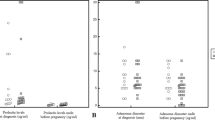Abstract
Dopamine-agonists have significantly increased the number of pregnancies in women with micro- and macro-prolactinomas, as ovulation can be restored in the great majority of these patients. Thus, the main questions regard the possible consequences of high estrogen levels on tumor volume and the possible effects of D2-agonists on fetal development. While the risk of tumor increase is low in patients with prolactin secreting micro-adenoma (MIP), in PRL secreting macro-adenoma (MAP) patients the possibility of tumor growth is enhanced and influenced by previous treatment. Moreover, while it is well known that the exposition for only the first 4 weeks to bromocriptine (BRC) therapy does not affect the outcome of pregnancy, data on the use of BRC during the whole gestation are limited to just over 100 cases. Female pregnant patients with MIP, therefore, must be reassured and medical therapy suspended, with successive clinical follow- up. In the case of pregnant MAP subjects, the best approach from pre-pregnancy debulking, dopamine-agonist therapy interruption and BRC therapy continuation must be agreed on with the patient, and a careful follow-up instituted.
Similar content being viewed by others
References
Gemzell C., Wang C.F. Outcome of pregnancy in women with pituitary adenomas. Fertil. Steril. 1979, 31: 363–372.
Molitch M.E. Disorders of prolactin secretion. Endocrinol. Metab. Clin. North Am. 2001, 30: 585–610.
Scheithauer B.W., Sano T., Kovacs K.T. et al. The pituitary gland in pregnancy: a clinicopathologic and immunohistochemical study of 69 cases. Mayo Clin. Proc. 1990, 65: 461–464.
Harris H., Valcavi R., Artioli C. The influence of estrogens on the sensitivity of prolactin, TSH, and LH, to the inhibitory action of dopamine in hyperprolactinemic patients. In: Mac Leod R.M., Scapagnini U. Thorner M.O. (Eds.), Prolactin basic and clinical correlates. Liviana Press, Padova, 1985, pp. 573–582.
Cramer O.M., Parker C.R., Porter J.C. Estrogens inhibition of dopamine release into hypophyseal portal blood. Endocrinology 1979, 104: 419–423.
Caron R.W., Deis R.P. Participation of opioid and serotoninergic systems in prolactin secretion induced by hypothalamic action of estradiol. Neuroendocrinology 1996, 64: 124–128.
Dericks Tan J.S., Taubert H.D. Elevation of serum prolactin during application of oral contraceptives. Contraception 1976, 14: 1–8.
Wingrave S.J., Kay C.R., Vessey M.P. Oral contraceptives and pituitary adenomas. BMJ 1980, 280: 685–686.
Davis J.R., Selby C., Jeffcoate W.J. Oral contraceptive agents do not affect serum prolactin in normal women. Clin. Endocrinol. 1984, 20: 427–434.
Elias K.A., Weiner R.I. Direct arterial vascularization of estrogen- induced prolactin-secreting anterior pituitary tumors. Proc. Natl. Acad. Sci. USA 1984, 81: 4549–4553.
Rijosk H.K., Fahlbush R., von Werder K. Influence of pregnancies on prolactinomas. Acta Endocrinol. (Copenh) 1982, 100: 333–336.
White M.C., Rosenstock J., Anapliotou M. et al. Heterogeneity of prolactine response to oestradiol benzoate in women with prolactinomas. Lancet 1981, 1: 1394–1396.
Mornex R., Hugues B. Remission of hyperprolactinemia after pregnancy. N. Engl. J. Med. 1991, 324: 60.
Molitch M.E. Pregnancy and the hyperprolactinemic women. N. Engl. J. Med. 1985, 312: 1365–1370.
Molitch M.E. Management of prolactinomas during pregnancy. J. Reprod. Med. 1999, 44 (Suppl.): 1121–1126.
Lamberts S.W.J., Kliin J.C.M., de Lange S.A. et al. The incidence of complications during pregnancy after treatment of hyperprolactinemia with bromocriptine in patients with neurogically evident pituitary tumors. Fertil. Steril. 1979, 31: 614–619.
Bergh T., Nillius S.J., Wide L. Clinical course and outcome of pregnancies in amenhorroeic women with hyperprolactinemia and pituitary tumors. BMJ 1978, 2: 875–870.
Magyar D.M., Marshall J.R. Pituitary tumors and pregnancy. Am. J. Obstet. Gynecol. 1978, 132: 739–751.
Cunnah D., Besser M. Management of prolactinomas. Clin. Endocrinol. (Oxf.) 1991, 34: 231–235.
Raymond J.P., Goldstein E., Konopka P. et al. Follow up of children born of bromocriptine-treated mothers. Horm. Res. 1985, 22: 239–246.
Canales E.S., Garcia I.C., Ruiz J.E., et al. Bromocriptine as prophylactic therapy in prolactinoma during pregnancy. Fertil. Steril. 1981, 36: 524–526.
Turkalj I., Braun P., Krupp P. Surveillance of bromocriptine in pregnancy. J. Am. Med. Assoc. 1982, 247: 1589–1591.
Robert E., Musatti L., Piscitelli G., et al. Pregnancy outcome after treatment with the ergot derivative, cabergoline. Reprod. Toxicol. 1996, 10: 333–337.
Ciccarelli E., Grottoli S., Gaia D., et al. Long-term treatment with cabergoline, a new long lasting ergoline derivative, in idiopathic or tumorous hyperprolactinemia and outcome of drug-induced pregnancy. J. Endocrinol. Invest. 1997, 20: 547–5510.
Molitch M.E. Pathologic hyperprolactinemia. Endocrinol. Metab. Clin. North Am. 1992, 21: 877–901.
Reilly P.L. Prolactinomas: surgical results and prognosis. In: Landolt A. M., Vance M.L., Reilly P.L. (Eds.), Pituitary Adenomas. Churchill Livingstone. 1996, 363–368.
Brodsky J.B., Cohen E.N., Brown B.W. Jr., et al. Surgery during pregnancy and fetal outcome. Am. J. Obstet. Gynecol. 1980, 138: 1165–1167.
Ruiz-Velasco V., Tolis G. Pregnancy in hyperprolactinemic women. Fertil. Steril. 1984, 41: 793–805.
Author information
Authors and Affiliations
Rights and permissions
About this article
Cite this article
Chiodini, I., Liuzzi, A. PRL-secreting pituitary adenomas in pregnancy. J Endocrinol Invest 26, 96–99 (2003). https://doi.org/10.1007/BF03345132
Received:
Published:
Issue Date:
DOI: https://doi.org/10.1007/BF03345132




